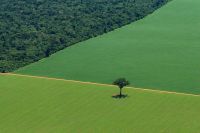Friday, April 19, 2024
News and Views from the Global South
ARGENTINA: Two Centuries of Environmental Destruction
Marcela Valente
- In the 1830s, the sheer abundance and diversity of plants and animals in Argentina — whether on land or in the water — astounded British naturalist Charles Darwin during his famed tours of South America.
“Until a few decades ago, we were warning about endangered species, but now the fear is that entire eco-regions will disappear,” naturalist Claudio Bertonatti, of the non-governmental Fundación Vida Silvestre Argentina (Wildlife Foundation), told IPS.
“If we could put a satellite image from 200 years ago next to one from today, we would see that the forested area has diminished in size and quality. The wooded areas left are much smaller and with less variety of species,” he said.
According to the expert, Argentina developed without planning, which has carried an enormous cost for the environment. “We had terrible administration of resources and it didn’t help us develop. In fact, we have more and more poor people,” Bertonatti said.
For the last 200 years, this South American country — which now has a population of 38.2 million — has seemed to be bent on destroying its forests. Even back in 1810, Manuel Belgrano (1770-1820), a founding father and creator of the national flag, expressed alarm about such negligence.
“We have seen woodsmen take down a lush, leafy tree just to test the blades of their axes. It is terribly moving to see so many dead trees. One already has a premonition of how detestable we will be in the coming generations,” Belgrano wrote.
In 1915, Argentina had 100 million hectares of forest – nearly a third of the national territory. Although there are doubts about the veracity of this official figure, there is no question about the magnitude of the destruction.
By 1937, the agricultural census determined that the total area was 37.5 million hectares, and by 1987 it was 35 million. Ten years later, the area covered by forests had been reduced to 33 million hectares.
Deforestation accelerated to make room for intensive farming. Currently, more than half of the cultivated area in Argentina is planted in transgenic soy, which China buys in massive quantities to feed its livestock. The boom in soy has had a major impact on the environment, as documented by numerous studies.
With the loss of forests, wildlife also suffers. The herds of more than 500 guanaco (a cousin of the llama) that Darwin saw here, the fear of encountering a jaguar and the awe-inspiring diversity of species have been relegated to Argentina’s natural history.
Darwin wrote in his travel diary (1831-1835) that the “rodent order” was very numerous, and that he collected no less than 80 different mouse species.
According to Bertonatti, six species have already gone extinct in Argentina. But there are also 500 vertebrate and 250 plant species that are endangered. The introduction of exotic species does not make up for the loss. On the contrary, it causes great harm to the native wildlife and ecosystems.
The advance of the agricultural frontier beyond the fertile zone of the humid pampas, in Argentina’s central-eastern region, has not only demolished forests, grasslands and wildlife, but has also caused severe deterioration of the soils – and sped up the desertification process.
In 40 years, the soil lost 11 million tonnes of nitrogen and 2.5 million tonnes of phosphorous, agricultural engineer Walter Pengue, of the University of Buenos Aires’ Landscape and Environmental Ecology Group, told IPS.
Environmentalists and artisan fishing organisations have become the guardians of biodiversity in the nation’s rivers, lakes and coastal waters, but the rest of society seems deaf to their call to action.
The common hake (Merluccius hubbsi), the leading commercial fish species of the South Atlantic, is in crisis as a result of overfishing. In the last 20 years, hake stocks have shrunk by 80 percent, even though Argentina consumes less than five percent of the catch.
In freshwater, the case of the vast Paraná River, in Argentina’s northeast, is emblematic. The lack of management plans, the large hydroelectric dams, and continued industrial fishing threaten wildlife and river communities alike.
As for the water resources themselves, the outlook is sobering. The Matanza- Riachuelo basin, which runs through Buenos Aires, is a stark symbol of water pollution that began back in the first hundred years of Argentina’s independence.
The 64-kilometre river receives inflows of sewerage from homes and waste from thousands of factories, and on its banks are hundreds of open-air garbage dumps.
In an article about the challenges in the year of Argentina’s bicentennial, María Eugenia Di Paola, executive director of the non-governmental Fundación Ambiente y Recursos Naturales (Environmental and Natural Resources Foundation), enumerated the problems.
Speaking with IPS, Di Paula said, “Unfortunately in 200 years the environment was never a focus of the country’s strategic decisions, and the great challenge now is making it a priority in policy-making.”
In her view, it is essential to integrate environmental matters into policy decisions through government transparency, which means providing reliable information, and requires a society willing to make up for lost time.
“The bicentennial is an opportunity to move towards a model of sustainable development,” said Di Paola, who warned that failure to do so will bring a level of environmental destruction from which there will be no turning back.

 Print
Print




